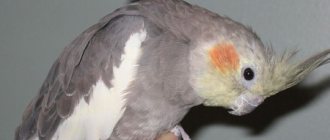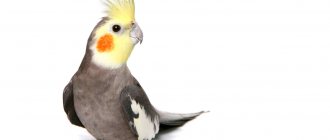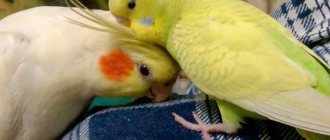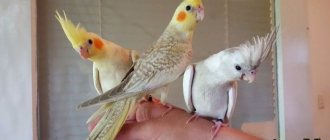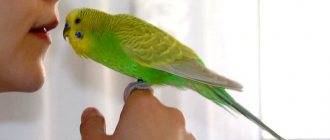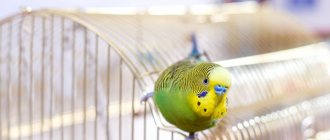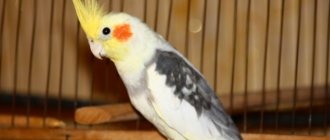Corellas are very sociable and intelligent birds. They can charm a person with their cheerful nature, love and friendly communication. This parrot loves to be in the company of its owner. Therefore, quite often a cockatiel or a nymph (another name for the same parrot) can be seen on the head or shoulders of its owner. This parrot shows its mood, ranging from happiness, curiosity, fear, illness or sadness, with the help of a crest above its head.
It is not easy for a new owner to immediately understand the character and behavior of his cockatiel. The best way to figure this out is observation. Take a closer look at your pet, note how he behaves in a given situation. After some time, you will begin to understand the behavior of the cockatiel by external signs. Then it will not be difficult for you to determine what the parrot wants. Cockatiels have a very playful character and active behavior. Head bobbing, beak scratching and rubbing, hanging upside down and tail wagging are some of the common behavioral characteristics you may notice in your budgie. The article describes what the behavior of a male or female cockatiel parrot may be like.
How can a bird adapt to a new place?
If the cockatiel trembles and cackles in a new place, he is scared. Don't create stressful situations. He is tense and afraid of literally everything: slamming, rattling doors, barking dogs, crying children. At first, you need to take care of how to establish contact with the parrot.
First you need to create conditions that are comfortable for the bird:
- Place the cage in a quiet place.
- Protect from exposure to TV and radio.
- Restrict access to households and pets.
- Warn not to look into the cockatiel's cage unnecessarily. Approach it only to add food and change water.
- Provide the bird with everything it needs.
In this mode, the bird will spend several weeks looking closely and getting used to its new home. If possible, the same person should talk to and look after him. This way the parrot will recognize and remember its owner, in his presence it will feel protected and will not show a bad character.
Keeping a Corella parrot at home
There are no difficulties in keeping a Corella parrot at home, so this process is accessible even to inexperienced lovers of keeping birds at home. Still, certain rules must be followed.
Cage structure
This bird likes its conditions to be as free as possible, so it will not feel comfortable in a cramped cage. In this case, you should pay attention to cells measuring 60x60 or 70x70 centimeters at least. At the same time, the door must be of such a size that the bird can freely fly out of the cage and return back.
Important to remember! Experienced bird owners recommend purchasing a cage that has larger vertical than horizontal dimensions. A cage of 60x50x50 cm is suitable for keeping one bird, and a rectangular cage with dimensions of 150x70x70 centimeters is suitable for two birds.
The cage is made of metal wire, but it should not have a paint coating. A retractable tray should be provided at the bottom of the cage. To avoid scattering of feed and splashing of water, some kind of sides should be built in the lower part, possibly made of plastic. The cage should be equipped with several perches, a feeder, a water container, and several toys.
Care and hygiene
Firstly, you need to choose the right place for the birds, since they are quite heat-loving birds. It is believed that they do not tolerate temperature changes well. As a result, the parrot may get sick or even die. Therefore, you should think about ensuring that there is no draft in the place where the birds are located, and the air temperature should be at the optimal level.
Interesting fact! According to the owners of Corella parrots, these birds are quite susceptible to foreign odors in the room, such as cigarette smoke, perfumes, disinfectants containing chlorine, including air fresheners.
The most optimal temperature for keeping a Corella parrot is from 22 to 24 degrees Celsius. There is one more factor to pay attention to. When heating devices are turned on in winter, a decrease in air humidity is observed in a person’s home, which negatively affects the health of birds. You always need to ensure that the filler in the cage is changed regularly, and that drinkers, feeders and all toys are washed once a week.
What to feed your cockatiel parrot
The well-being of birds, as well as their health and, ultimately, the life expectancy of pets depends on proper, healthy nutrition. This definition is considered relevant not only in relation to the content of the Corella parrot.
Important to remember! According to experts, high-quality and balanced foods, such as Vitacraft for Corella, Padovan, Prestige, and Vaca, are considered the most suitable.
In any case, preference should be given to purchased, ready-made, complete food. Birds don't eat much, so don't skimp on their health. At the same time, you should know that the basis of any feed, regardless of its cost, is: millet, oats, wheat, sunflower and corn. If the food is more expensive, then nuts, minerals, oils and yeast are also added to it.
Lifespan
Living in natural conditions, these birds rarely live to be ten years old, since they constantly have to look for food for themselves, putting their lives in danger.
If you keep a parrot in artificial conditions, following all the rules of keeping, then the pet can live for almost 20 years, or even more, as evidenced.
Poultry diseases and their prevention
In case of illness, the bird’s behavior changes, and the following symptoms may appear:
- Difficulty or rapid breathing.
- Inflammation of the skin.
- Baldness.
- The appearance of growths or detachments on the beak.
- Vomit.
- Diarrhea or constipation.
It is believed that the most common are plumage problems associated with improper molting process, as well as self-plucking.
The appearance of problems with the gastrointestinal tract, expressed by gastroenteritis and dysbacteriosis, is also considered not uncommon. As you know, it is easier to prevent diseases than to treat them later. Therefore, the best way to combat diseases is their prevention, which consists of properly keeping the parrot and providing it with a balanced diet. Regular visits to the veterinarian won't hurt.
Is it possible to teach a cockatiel to talk?
Many people are interested in the question of whether a Corella parrot can be taught to speak. Compared to budgies, which are considered more "talkative", the Corella parrot can pronounce words more clearly and more intelligibly. Almost every representative of this family has the ability to imitate human speech. If you regularly work with your parrot, he can learn to “pronounce” individual words and even entire sentences. In addition, the bird is able to remember other sounds, for example, simple melodies.
Interesting fact! The Corella parrot has a rather sharp and shrill voice, which leads to the distortion of spoken words, as well as the accompaniment of speech by melodic sounds made by the parrot. Therefore, we can say that the parrot has its own, very impressive vocabulary.
HOW TO TEACH A PARROT TO TALK / My experience and successes with CORRELLA
Communication and tactile contact
Patience, affection and attention will allow the bird to become a full-fledged member of the new family. In any situation, if it is not clear how to calm the parrot, you need to remain calm yourself. You cannot shout, hit the cage with your hand, or get irritated.
To establish contact at first, try to spend all your free time near your pet. You can talk to him affectionately, quietly sing melodic songs, treat him with fruit. This is known to always work.
If the cockatiel is trembling and clucking, you need to calm him down in a quiet, gentle voice. After a week, the bird will get used to the presence of the owner and will calmly react to his appearance. The behavior of cockatiels often depends on the situation in the house. With calm owners, the bird is also cheerful and content.
As soon as the bird stops being nervous about the presence of a person near its home, then you can try to accustom it to hands. First, they try to hand feed her, sticking her palm with food into the cage. If the parrot tries to bite, you need to remove the treat and strictly say “No,” you can gently click on the beak. Over time, he will understand that he should not do this.
At the same time, you should not wear protective gloves on your hands - they will scare away the pet even more.
The character and habits of the cockatiel
Cockatiels in a new home choose one owner for themselves. And only he will be the main part of their life. At an early age, parrots are particularly naive and gullible. They are easy to learn and train, and get along well with other birds.
Interesting! Birds prefer a female voice timbre. It is women who most often become their favorites.
Some compare the behavior of these parrots to small children. They are very curious and active. If the bird is kept in a cage, it will spend most of its time watching its owners. And with free access, he will be interested in everything. If the owner is reading a book, the cockatiel will fly up and look into it, even “taste” the pages.
In such situations, harmfulness may manifest itself. If the book is not to your liking, parrot droppings will appear on it. In this way, different species show their dissatisfaction. You can correct the situation if you remove the object you don’t like or try to correct the behavior of the bird.
In addition to flying around the room, these parrots love to sit on furniture or quickly run across the floor. Toys bring no less joy to birds.
But despite the variety of entertainment, they need regular human communication. Without it, pets experience severe stress and become wild. Aggression combined with depression often leads to the death of birds.
How to avoid bird bites
The pet hisses and shakes when it wants to protect its home. Perhaps it is too early to accustom him to holding hands. But it’s time to ask how to properly wean timid cockatiels from biting. First of all, natural causes that cause aggressive behavior are excluded: molting, diseases, mating season. If everything is in order, the cockatiel parrot is taught to behave calmly.
What to do in this case:
- Teach to understand the “no” command by clicking on the beak or cage to attract attention.
- If the bird is ready to attack, you can distract it with a bright toy. Find out why your cockatiel is acting aggressively: he is afraid or he has negative experiences with people.
- You can spray water on it if other methods do not help.
But when you hear the cockatiel creaking its beak, rest assured: he is used to the house and is happy. Experienced poultry keepers admit: this is the best sound you can hear from a pet.
Some behavioral features
Parrots express their emotions not only by screaming and gnashing. Even yawning, raising your tuft or standing upside down will tell you about them.
Raising the crest
For cockatiels, this movement is similar to how humans raise their eyebrows. This happens during times of great surprise, fear, and confusion. The bird raises its crest and hisses during intense fear. And anything calls it:
- other birds or animals;
- any items;
- bright light in the window;
- loud sounds.
In addition, the pet raises its crest when upset or angry. In such cases, it is not recommended to approach the cage closely. It is better to talk carefully and calmly with the parrot and try to calm it down.
Hanging upside down
When a parrot hangs upside down and at the same time spreads its wings in different directions and fluffs its tail, this often leads to bewilderment of owners. In this position, he can actively flap his wings. In this unusual way, the bird communicates to others its desire to swim and splash in the water.
If the female sits on the eggs and also flaps her wings, in this case she is protecting her home. Such warnings indicate a possible attack if danger arises or comes close to the cage.
Yawn
Cockatiels yawn for several reasons:
- lack of oxygen;
- removing plugs from the ear canal;
- clearing the throat of dust;
- allergic reaction.
Important! A parrot's warm paws indicate its health.
But if yawning is accompanied by head shaking, you need to watch your pet. Such symptoms are characteristic of respiratory diseases, problems with the respiratory tract, and the development of infections.
How to deal with loud screaming
In the wild, parrots make all sorts of loud sounds without caring about those around them. The apartment cockatiel also likes to scream, but this does not always suit the owners. When purchasing, few people take this nuance into account. Only when faced with a sharp and unpleasant cry from a pet does the owner look for a way to quickly wean the cockatiel bird from screaming.
There are several effective ways to cope with screaming:
- Buy him a pair. Together, the birds feel more confident, they have no time to be bored, they are busy with each other.
- Play melodious music quietly. This calms Corella down. He even dances.
- Corella yells if people yell at him. He is a good imitator, so you need to speak to him quietly and gently.
- Check the feeder and drinker. Perhaps the bird is just hungry, and everyone is only concerned with how to stop it from screaming.
- In the evening, you can simply send a wild cockatiel to bed by turning off the light.
By this, the owner demonstrates that the household does not intend to listen to wild screams. Over time, the pet will understand that this is not worth doing.
Possible difficulties and errors
The main difficulty in taming a cockatiel is that as it grows, its character changes. At some stages of life they become especially aggressive and self-confident. But the owner’s patience will help overcome the age crisis.
When taming a nymph, the following mistakes should not be made:
- force events, hope for a quick result;
- do not pay attention to the pet’s mood and condition;
- perform actions against the will of the cockatiel;
- wave your arms sharply, shout, roughly grab or even hit the bird;
- turn on household appliances with a sharp loud sound near the cage;
- conduct classes several days a week rather than daily;
- have other people take care of your cockatiel while it is being tamed;
- forget about praise and encouragement;
- As a punishment for bad behavior, go on hunger strike to the parrot.
These actions will have a bad effect on the cockatiel, then at best the taming process will be delayed, at worst the bird will completely lose trust in the owner, will show aggression or even get sick.
Bird behavior depends on productive sleep
Excitability is directly related to how long the harmful cockatiel sleeps. For normal functioning, he needs 10 hours of quiet, deep sleep.
When a cockatiel sleeps, the following rules should be observed:
- Turn off the radio and TV during daytime naps.
- Cover your pet's cage while sleeping at night to prevent light and sounds from waking him up.
- Protect the bird from harsh sounds.
If the bird gets a full 10-hour sleep, you won’t have to wonder why the parrot is lethargic or excitable in the morning.
Scream
Seeing your beloved pet scream and squeal is a frightening sight. The following reasons for this behavior in cockatiels are identified:
- Adverse changes in the environment.
- There is too much noise around the cage.
- You are going to leave the bird alone.
- The parrot doesn't get enough sleep.
On average, cockatiels need to sleep at least 10 to 12 hours a day.
If there are children in the house
Kids rejoice at the appearance of a colorful pet in the house, but there are a number of rules that parents should teach their children. It is important to properly arrange a home where there are birds and a small child.
To avoid any troubles, children are explained what they should absolutely not do:
- Screaming near the cage. Tell your child why the parrot is afraid of sharp sounds.
- Play with the bird like a toy: flapping, pulling out feathers, strangling.
- Open the cage without adult permission. Explain that the bird flies well and can slip out of the open window.
- You can't have a cockatiel and your small child living in the same room.
Also, parents should show by their own example how to calm excited cockatiels and how to care for them. You can train the bird together and show your child in a playful way how to wean the bird from being afraid of people.
How to tame an adult cockatiel
The process of taming an adult bird is no different from training chicks. Here, too, it is important to be patient and not to rush. If a person suddenly climbs into the cage and tries to forcefully get the bird, he will provoke aggression. Then the bird will lose trust in its owner for a long time.
Taming should take place gradually:
- During the adaptation period, you need to be near the cage more often to encourage the cockatiel to observe. If she calmly eats, drinks water or chirps in the presence of a person, then this indicates a certain degree of trust.
- When the bird looks at the person with interest, he may begin to talk to her.
- You need to observe which food the nymph likes best; this knowledge is used in the process of taming. These can be seeds (pumpkin, sunflower, flax), sweet berries, pieces of banana, apple, pear, orange slice. Corella will not refuse carrots, cucumbers, and tomatoes.
- You should try giving treats to your cockatiel through the bars of the cage. If she is interested in the proposal, then this action should be repeated daily. After mastering the skill, you can teach the bird to eat from your hand. It is better to do this in the morning before meals.
- At the next stage of hand taming, the nymph is taught to sit on the fingers.
- You can tame a parrot with the help of toys. They are naturally curious, especially the young. To make friends with your pet, lure it with bright balls, feathers, and jingling bells. The main thing is that the item is small and colorful.
If the parrot flies away
A bird owner may leave a window or door open and not notice the cockatiel flying away. We need to try to get him back. You need to understand that the pet is not far away. He, scared and confused, hides in a tree in the yard.
To attract the attention of a fugitive, do the following:
- Play a recording of the chirping of parrots of his species or melodious music on the windowsill.
- They place a feeder with his favorite food on the window.
- If there are other birds in the house, take them outside in a cage.
- You need to walk along the nearest streets and call your pet. Perhaps he will respond.
Not always, if a cockatiel parrot has flown away, it is useless to look for it. But the likelihood that, under the influence of hunger, he will find his way to another house is high. The death of the bird is not excluded.
Winning the heart of a cockatiel is not difficult if you work at it every day. The main tool for creating a friendly relationship with your pet is love and patience. Over time, the nimble bird will become a full member of the family. Her sweet talk and awkward dances will not let you get bored even on the gloomiest days. And remember: let your cockatiel squeak his beak more often.
Determining the sex of a parrot
At first glance, males and females are very similar. Those ignorant of this issue can easily confuse them. But, there are signs that unmistakably determine the sex of a bird. The main thing is to know where to look.
By the crest
Take a close look at the bird's crest. If it is narrow, then this is a male. Females have wide crests covering the entire forehead. But there are exceptions. Determining the width of the crest requires a little experience.
It is also worth noting the number of long feathers. Boys have no more than 3 of them, but females can have up to 6 of them. A greenish tint to the long feathers of males is also noted.
By plumage
The color of the plumage can determine the sex of any species of parrot. In cockatiels, differences in plumage color have their own characteristics:
- Males - the plumage of the head has a yellow tint, the cheeks are pink.
- Females - the head has a gray tint of feathers, the cheeks are also pink, but not as bright as those of males.
Birds receive such plumage only after the first molt, which occurs at approximately 7 months. Before this period, it is almost impossible to determine the sex of a bird by plumage.
It is worth noting that the above color combinations of parrot feathers are characteristic only of “purebred” cockatiels. If there was crossing of species, then the color of the bird will be individual.
According to body shape
Not only in plumage do males surpass females in beauty, but also in body shape. Females have a small hump on their back between the wings. Males don't have this.
Their wings are more graceful and pointed. In comparison, males try to look stretched and cheerful. When the females are calm, they sit with a little bristling.
Take a closer look at the belly plumage; females have a small parting there. It is also worth focusing on the placement of the paws. In girls they are more widely spaced than in males, which is explained by their physiology.
The tails are also different. In males they are pointed, beautiful and well-groomed. When females have tails that are slightly sloppy and fluffy.
DNA test
If none of the above signs can accurately determine the gender of the cockatiel, you can use medical services. A DNA test can determine the sex of a parrot with 98% accuracy. Not all cities conduct such tests. And the price tag for them is not low - from 15 dollars.
To do such an analysis, you need to collect 5-6 isthmus of a feathered pet. Please note that they must be taken from the feathers and must not be lost. The feathers must be sent to the laboratory no later than the second day of collecting feathers, otherwise the test will not be accurate.
If there is no specialized laboratory in your city, you can send biological material for analysis by mail. Again, consider the time frame within which feathers need to be submitted for analysis.
Fighting bites
New or future parrot owners need to know what to do when handling a parrot if it bites and is afraid. It is necessary to understand that the bird does this because it feels threatened by the person and does not trust him.
If the cockatiel begins to bite during taming, the owner should react as neutrally as possible. Do not suddenly withdraw your hand, cry out, or urgently finish classes. This reaction may encourage the cockatiel to attack its owner in the future. The bite is painful, but you must try to restrain yourself.
Important! If the cockatiel hisses, raises its crest high or presses it, then it is preparing to attack. Therefore, it is better to gently remove your hand from the bird and allow it to calm down.
If the owner is trying to tame a cockatiel and it constantly bites and is afraid, then you need to think about protecting your hands. It is better to carry out classes with thick gardening gloves to slightly reduce the pain from the bite.
You cannot punish a nymph for biting and being afraid. The bird still won’t understand why a person yells at it or hits it. However, trust in the owner will disappear after such actions. It is better not to pay attention to such actions, deliberately ignore the pet or take away his favorite toy.
The owner should focus on rewarding commands and good behavior. Then the parrot's taming will speed up.
Features of choosing a home for Corella
Next, let's talk about a house for our bird, which should be not just a cage, but a real amusement park at a time when you are busy with your own business and the parrot gets bored.
Dimensions and shape
The cage should allow the bird to fly a little. Of course, you don’t need to buy a “house for an elephant,” but you shouldn’t put him in a small “prison” either. Let us immediately draw your attention to the fact that cages for budgies are not suitable, because these species have different temperaments, sizes and behavior.
Therefore, we need a spacious cage in which we can place many different “attractions” but still have some free space.
The cage for Corella has the following dimensions - 100x40x60 cm. These are the minimum parameters from which to build. It should be long and wide, for which the largest indicators are responsible. This is due to the fact that the bird moves vertically, not horizontally.
Arrangement of the cage
In addition to the standard set that is included in the purchased cage, we recommend immediately purchasing chalk in the form of a stone, a drinking bowl, and 2-3 small toys.
After inspecting the nearby fruit trees (but not near the road), pick a couple of small branches with bark and put them in the cage. You can buy a “head of cabbage” of pressed cereals or buy some dried fruits at a pet store.
Important! Toys should not be dangerous, so they should only be purchased at a pet store.
You shouldn’t turn the house into a warehouse, but you shouldn’t leave it empty either. The parrot should not be bored, otherwise it will begin to distract you from more important concerns.
How to teach a parrot to talk?
The nymph's onomatopoeia consists of sounds reminiscent of chirping. Words can be pronounced more or less legibly, the vocabulary is individual. A chick up to one year old can be taught to speak. Males are considered more talented students.
How to teach talking:
- In the morning or evening, curtain the cage with a cloth that does not allow sunlight to pass through so that the bird calms down and prepares for the lesson;
- repeat a certain phrase or word many times;
- preference should be given to words with hissing letters;
- reward occasionally with treats.
Learning the first phrases, if the bird is less than a year old, takes only 4-5 weeks. The main thing is to learn to speak every day. The bird being trained must be absolutely tame. It’s good if during a lesson the pet blinks slowly and closes its eyelids - this indicates that it is listening attentively to its owner.
